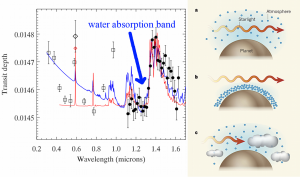In journa l club this morning, we discussed the recent paper by Deming et al. (2013), just accepted for publication by the Astrophysical Journal. In this study, the authors observed the planetary transits of HD 209458 b and XO-1 b using the Hubble Space Telescope in the near-infrared (about 1-1.6 microns in wavelength) to look for spectral features of water and other molecules. These features tell us whether water and other molecules are present in a planet’s atmosphere, how abundant those molecules are, and even where the atmosphere they are located. In this case, the authors saw spectral absorption from water molecules (see the left portion of the figure at left), but the amount of absorption (the depth of the absorption band) isn’t as large as it would be if the atmosphere were clear. Instead, the relatively shallow absorption feature suggests that there are clouds or haze suspended high in the planet’s atmosphere.
l club this morning, we discussed the recent paper by Deming et al. (2013), just accepted for publication by the Astrophysical Journal. In this study, the authors observed the planetary transits of HD 209458 b and XO-1 b using the Hubble Space Telescope in the near-infrared (about 1-1.6 microns in wavelength) to look for spectral features of water and other molecules. These features tell us whether water and other molecules are present in a planet’s atmosphere, how abundant those molecules are, and even where the atmosphere they are located. In this case, the authors saw spectral absorption from water molecules (see the left portion of the figure at left), but the amount of absorption (the depth of the absorption band) isn’t as large as it would be if the atmosphere were clear. Instead, the relatively shallow absorption feature suggests that there are clouds or haze suspended high in the planet’s atmosphere.
The cartoon in the right portion of the figure shows how this works: Panel (a) illustrates the passage of light emitted by a planet-hosting star through a clear planetary atmosphere, on the way to the telescope. As the light passes through, the water molecules (blue circles) imprint their spectral absorption feature. By contrast, panel (c) illustrates the passage for a cloudy atmosphere. The clouds block a lot of the light before it reaches the telescope, and so only the photons that pass high above the clouds, where there’s not much water to absorb light, get to the telescope. As a result, the water spectral feature is less deep.
The new techniques developed in Deming et al. (2013) may open the door to totally new astronomical observations. For example, the authors suggest that the significantly improved sensitivity of their technique may allow astronomers to directly observe meteorological variability (weather) on these distant exoplanets.
